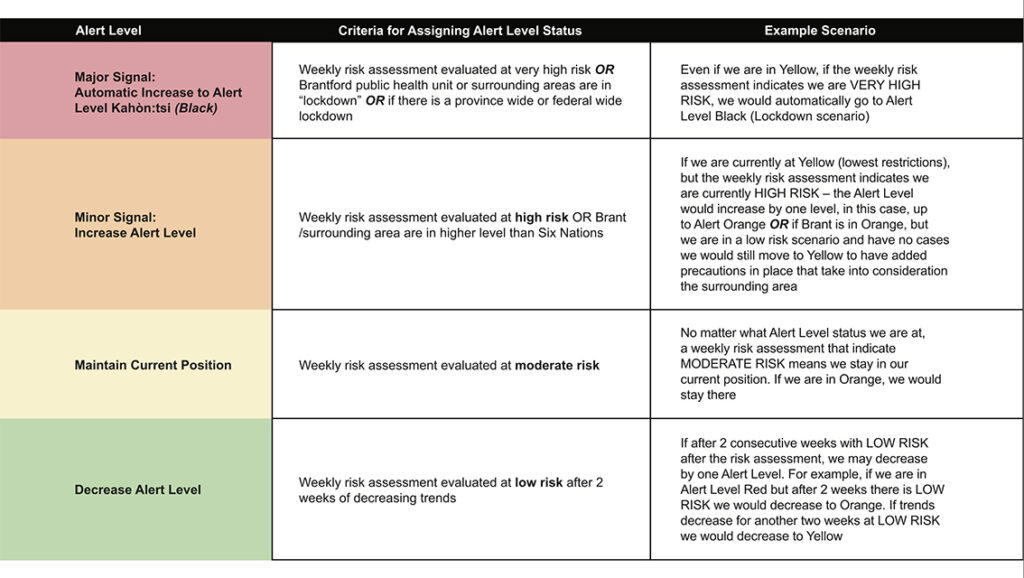
OHSWEKEN — Six Nations of the Grand River Elected Council has rejected two recent recommendations from public health officials to move the community into Black Alert level status, despite an increasing presence of COVID-19 variants and the provincial lockdown/stay-at-home order.
On March 23, Six Nations remained in Black Alert status and had 13 active cases with 1 person in hospital.
The following day, on March 24, Six Nations announced the first finding of variants of concern on the territory with two new cases identified — bringing that day’s total to 11 active cases and 1 person in hospital.
Upon the finding of those variants, Six Nations Emergency Control Group recommended the community remain in Black Alert Status due to the presence of COVID-19 variants identified in the community as well as rising case rates in the surrounding regions.
However, a source says SNGR rejected that proposal, arbitrarily deciding to downgrade the risk alert to Orange — two levels beneath what public health officials were recommending and contrary to the required alert level outlined in the Six Nations Pandemic Response Framework.
Later that day, SNGR publicly announced the community was being downgraded to Orange Alert level.
On March 25, the case count rose to 12 with the number of hospitalized band members increasing to 2. The alert status remained at Orange.
The source says the Emergency Control Group then made another recommendation to transition the community back to Black Alert status after the province announced it was heading into lockdown and was preparing to issue a stay-at-home order.
The source says that SNGR again, rejected it’s own Pandemic Response Framework and the recommendation from its public health officials and instead moved to Red Alert status.
Six Nations released it’s own Pandemic Response Framework in November 2020.
SNGR said work on the Framework began back in May 2020 and was approved to be implemented effective December 1, 2020 by Elected Council. Upon the document’s release SNGR said it “outlined the need for stricter control measures than the surrounding areas, in part due to increased risk factors for on-reserve band members.”
Those risks are outlined in the Framework, including a high prevalence of pre-existing conditions among band members. The framework says that over a third of Six Nations on reserve population is in the in the 50+ age demographic. Half of that demographic has high blood pressure. Nearly a quarter of that demographic has heart disease.
The Framework lists other socio-economic determinants of health like access to water and overcrowding in local housing that prompted a more aggressive approach to elevating alert level status during the pandemic.
SNGR said in a statement on December 1, 2020 that weekly assessments are conducted by the ECG’s Incident Management Team to determine what the current alert level should be.
Those assessments include “tracking indicators such as virus spread and containment, healthcare system capacity, Ohsweken Public Health capacity, Assessment Centre capacity and community compliance with public health measures.”
The Framework says Six Nations will follow suit in the event of a provincial lockdown.
It reads, “Our thresholds for action are stricter than Ontario’s, so we will increase our Alert Status more readily than other public health units.”
And again, “If Brant and/or Haldimand-Norfolk go into Lockdown or there is a Federal or Provincial lockdown, then Six Nations would go into lockdown as well.”
Currently both regions, as well as the rest of the province are in lockdown.
Brant County Health Unit is reporting 182 active cases with 40 reported in the last 24 hours. Seven people are in hospital. So far 152 confirmed cases of the UK variant and 2 cases of the Brazil variant have been detected in Brant.
Haldimand-Norfolk is reporting 129 active cases and says nearly 40 cases of variants of concern have been confirmed in that region.
Both Haldimand-Norfolk and Brantford-Brant are both a part of the province-wide lockdown and accompanying stay-at-home orders issued this week.
Premier Doug Ford advanced the lockdown with a stay-at-home order saying it was prompted by a surge in cases driven by Ontario residents travelling from restricted areas into those with looser restrictions.
Members expressed concern about this trend continuing at Six Nations, saying remaining in Red Alert status while the surrounding regions are on lockdown puts the community at an increased risk of non-resident visitors coming onto the territory.
Off-reserve, stores that sell goods such as groceries, cleaning supplies and pharmacy products can remain open but only to sell essential items.
Non-essential retail can open for curbside pickup or delivery only.
The stay-at-home order prohibits Ontario residents from leaving home except for work, medical appointments and to get groceries or medication.
TRT sent questions to both Elected Council and the Emergency Control Group for clarification on why the current alert status level does not match the Six Nations Pandemic Response Framework and why the council rejected the ECG recommendation.
No word from either group on that yet.








